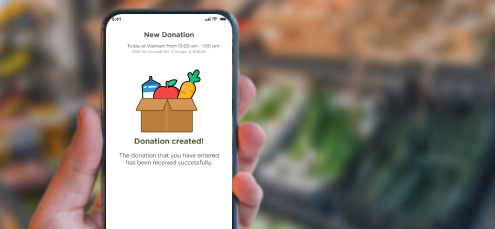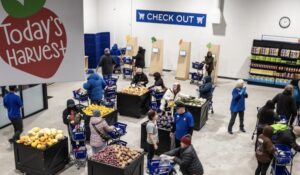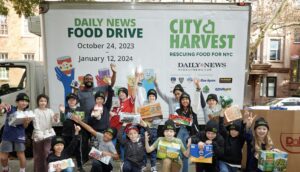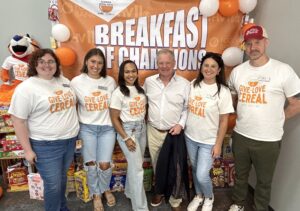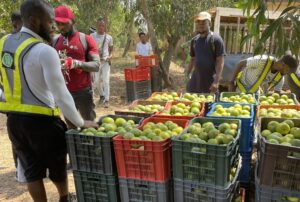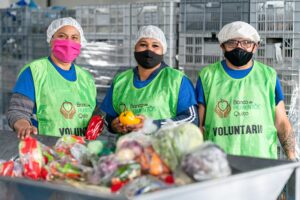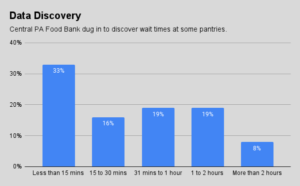In 2019, when Food Bank News first reported on Feeding America’s MealConnect, the app was being used by 22 food banks and had helped rescue 1.5 billion pounds of food over five years. Now, virtually all of Feeding America’s 200 food banks are using the app, and it helped rescue 1.2 billion pounds in 2022 alone.
More important than the app’s growth is the vision for where it’s headed. MealConnect has the distinction of being the only food rescue app that operates nationwide. The breadth of Feeding America’s network, combined with the depth of services the national office can provide to support it, is pushing MealConnect toward something that is much more than a simple food-rescue app.
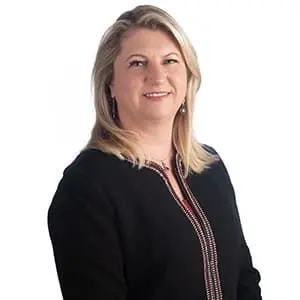
Food collected through MealConnect now accounts for about 20% of the six billion pounds of food distributed last year by Feeding America food banks. The vision is to have all the food sourced by Feeding America food banks go through MealConnect, while also building up the capacity to distribute that food by connecting thousands more pantries and agencies to the app.
At a time when so many cities are spawning food-rescue apps, Feeding America’s push toward a national solution is intended to make it the clear choice amid the clutter of smaller, regionally focused options. “It’s important that Feeding America food banks have a solution,” noted Eric Cooper, President and CEO of San Antonio Food Bank, one of 12 food banks that provides input into Feeding America’s technology initiatives.
A significant part of MealConnect’s evolution has been its expansion beyond rescuing food from grocers and restaurants to also sourcing large loads of produce directly from farms and food processors. Out of the 1.2 billion pounds collected through MealConnect last year, 400 million came from farms or processors, which is nearly half of the 950 million pounds of produce sourced that way by Feeding America in 2022.
To help food banks get their hands on that rescued produce, Feeding America is providing subsidies for transportation. The funding pays for third-party logistics companies to pick up produce by the truckload on behalf of food banks. Multiple truckloads can be distributed to multiple food banks, with Feeding America managing all of that coordination.
It also helps that Feeding America has seven regional produce cooperatives spread across the country that can help it manage distributions. The coops can accept produce on behalf of food banks unable to take full truckloads, then break it down and redistribute it in manageable amounts.
At the same time MealConnect is gathering up more pounds of food, it is tapping into the capacity of the Feeding America network to distribute it. Feeding America can use its insights into the customer side to ensure the rescued food goes to the nearest distribution point where there is both demand and capacity.
“We want to know where every customer that we’re serving is, where every pound that we’re collecting is, and where the demand and the gaps still exist,” said Maryann Byrdak, Chief Information Officer for Feeding America. “The power is in having all that data in one place and being able to grow and scale that.”
Byrdak sees an end-to-end system with MealConnect capturing all of Feeding America’s food sourcing, and a consolidated toolset providing a window onto the customer side. The full “MealConnect umbrella” will combine customer views via Feeding America’s Service Insights client intake tool, the Order Ahead grocery ordering tool, and a soon-to-be-launched client-facing tool called MyMealConnect where people can search for food assistance.
“Our technology is really focused on understanding our network, understanding our ecosystem, and then making those proper connection points,” Byrdak said. “That’s the power of what we’re driving.”
Over time, the enterprise resource planning systems that food banks use to manage their day-to-day operations (i.e. Ceres and Primarius) will be integrated into MealConnect. In addition to providing insights into how individual food banks are performing, the integration will record information about donated and rescued food at the local and national levels without any paperwork or retyping. “The whole goal is that it’s completely frictionless,” Byrdak said.
At a time when food banks are finding it increasingly difficult to source food, MealConnect’s approach would provide a single view of decision-making around food acquisition. Food banks do not source food from a single place, Byrdak noted, but work with many manufacturers, grocers, farms and food rescue apps. “We’re trying to have that single picture,” she said. Eventually, the MealConnect roadmap includes also having an integrated purchasing portal, she added.
Feeding America recently refreshed the MealConnect app by adding chat functionality, following a pilot with Walmart. The chat allows for more seamless communication compared to a flurry of phone calls and emails to coordinate food drop-offs or pick-ups. “We’re listening to our customers and understanding the features that our pantries and food donors want and building in those types of integrations,” Byrdak said.
The way-off vision is that individuals would be able to go to the app, discover places nearby where there is excess food, and pick it up themselves, addressing the problem of smaller-sized donations that go to waste because they’re too costly for food banks or agencies to pick up. “We’re not there yet,” Cooper said. “But it’s laying the groundwork for potential opportunities like that. It is the last mile.”
More immediate growth potential for MealConnect includes the many millions of pounds of uncollected excess food within the food system, as well as the thousands of pantries that can be pulled into MealConnect as distribution points. Currently, less than 20% of the food pantries/agencies connected to the Feeding America network are using MealConnect. Feeding America’s goal is to get 30,000 to 35,000 pantries on board.
Feeding America is also assessing the technological capabilities of the 70 to 90 food banks that are affiliates of Feeding America, but not part of the network, to see how they might best plug into MealConnect. Feeding America has not had any conversations with any non-Feeding America/independent food banks about using MealConnect. – Chris Costanzo
Like what you’re reading?
Support Food Bank News
